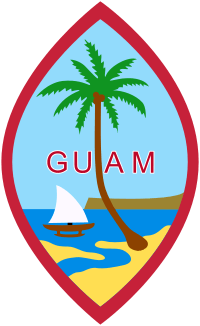1984 Guamanian general election
General elections were held in Guam on 6 November 1984 to elect the Legislature, the islands' delegate to the United States House of Representatives, Commissioners, Assistant Commissioners and the Territorial School Board.[1] Voters also voted on three referendum questions. Primary elections had been held on 1 September.[1]
 |
|---|
| This article is part of a series on the politics and government of Guam |
|
Results
Legislature
| Party | Votes | % | Seats | ||
|---|---|---|---|---|---|
| Republican Party | 267,727 | 50.6 | 10 | ||
| Democratic Party | 261,604 | 49.4 | 11 | ||
| Total | 529,331 | 100 | 21 | ||
| Source: Guam Election Commission | |||||
Delegate
| Candidate | Party | Votes | % |
|---|---|---|---|
| Vicente T. Blaz | Republican Party | 15,839 | 50.3 |
| Antonio Borja Won Pat | Democratic Party | 15,485 | 49.2 |
| Invalid/blank votes | 265 | – | |
| Total | 31,733 | 100 | |
| Registered voters/turnout | 38,952 | 81.47 | |
| Source: Guam Election Commission | |||
Referendums
Three proposals were put to voters:
- Proposal A – an amendment to Title 12 of the Guam Code to limit the amount that the Guam Power Authority could raise prices by, as well as changing how prices increased and to reduce prices back to those of 1 February 1983.[2]
- Proposal B – an amendment to Title 2 of the Guam Code to limit annual expenditure of the Legislature to £3m, reduce Senators salaries to $18,000 and the Speaker's salary to $19,500, make people personally responsible if they are responsible for breaking the cap and to reduce the number of sessions to 90 days during a two-year term.[3]
- Proposal C – an amendment to Title 2 of the Government Code limiting gubernatorial spending to 95% of the actual government spend two years previously and diverting remaining government funds to the general fund and Guam Retired Fund deficits and liabilities.[4]
| Choice | For | Against | Invalid blank |
Total | Registered voters |
Turnout | ||
|---|---|---|---|---|---|---|---|---|
| Votes | % | Votes | % | |||||
| Proposal A | 15,851 | 60.6 | 10,299 | 39.4 | 5,564 | 31,714 | 38,952 | 81.4 |
| Proposal B | 14,735 | 60.4 | 9,671 | 39.6 | 7,308 | |||
| Proposal C | 15,354 | 65.05 | 8,248 | 34.95 | 8,112 | |||
| Source: Guam Election Commission | ||||||||
gollark: I mostly get my reds via catching CB kindofrares and trading them for large groups of red hatchlings.
gollark: "What doesn't kill you makes you undead"
gollark: The dragon is, ironically, ded.
gollark: `What Doesn't Kill You` is unfortunately taken.
gollark: As opposed to dying?
References
- Election Comparative Analysis Report Guam Election Commission
- Guam (USA), 6. November 1984 : Fixierung der Strompreise Direct Democracy
- Guam (USA), 6. November 1984 : Kostenbremse für den Parlamentsbetrieb Direct Democracy
- Guam (USA), 6. November 1984 : Ausgabenbremse Direct Democracy
This article is issued from Wikipedia. The text is licensed under Creative Commons - Attribution - Sharealike. Additional terms may apply for the media files.